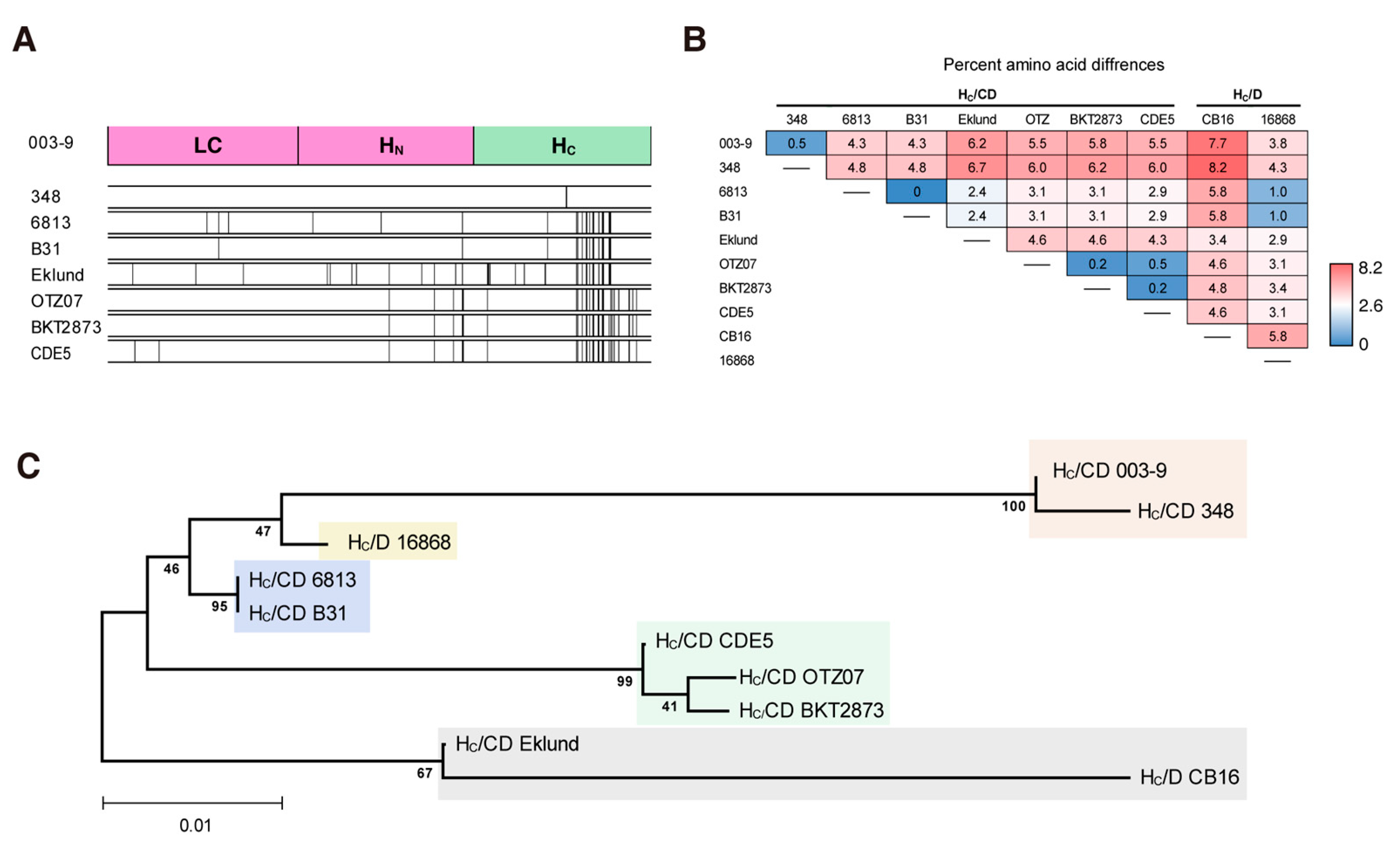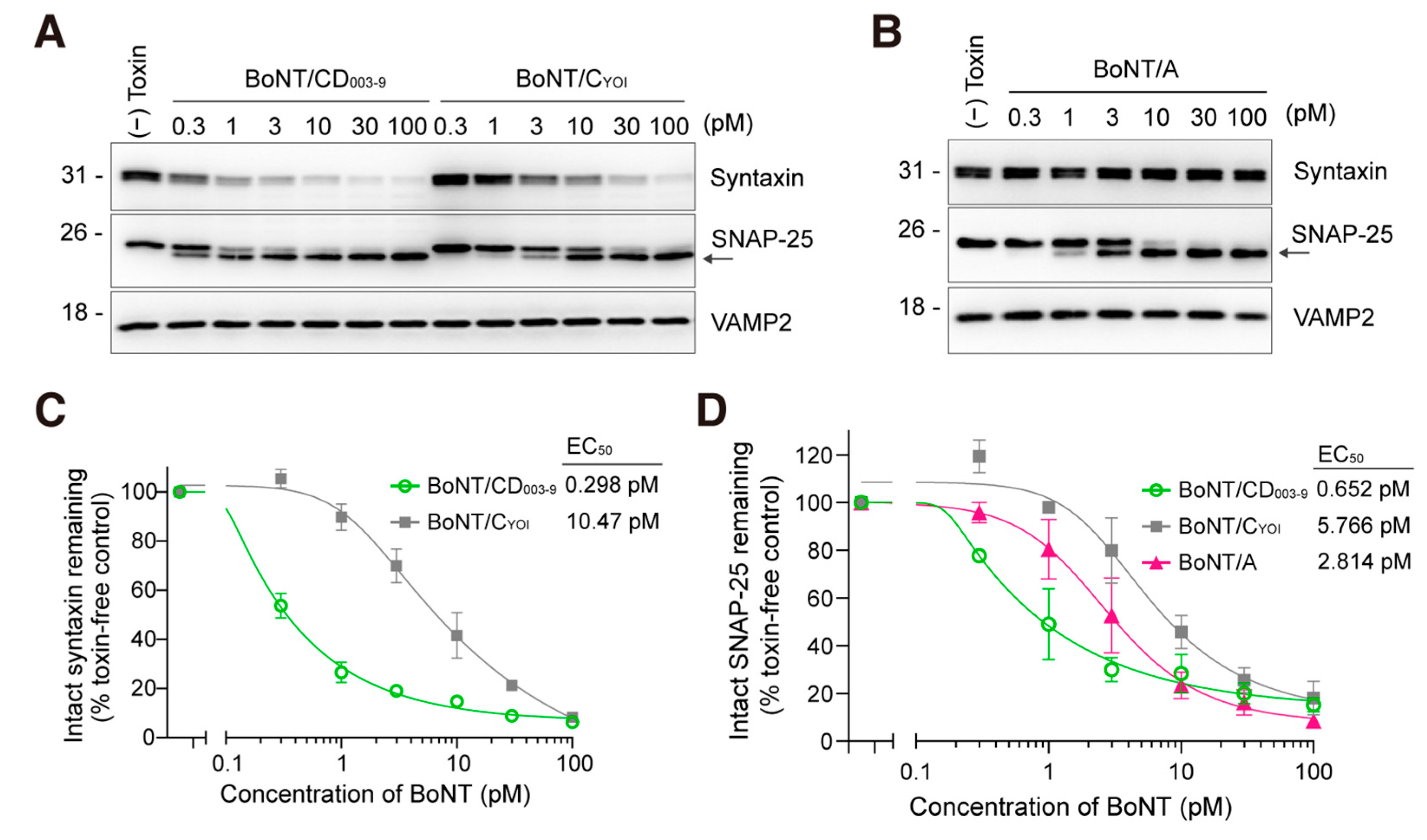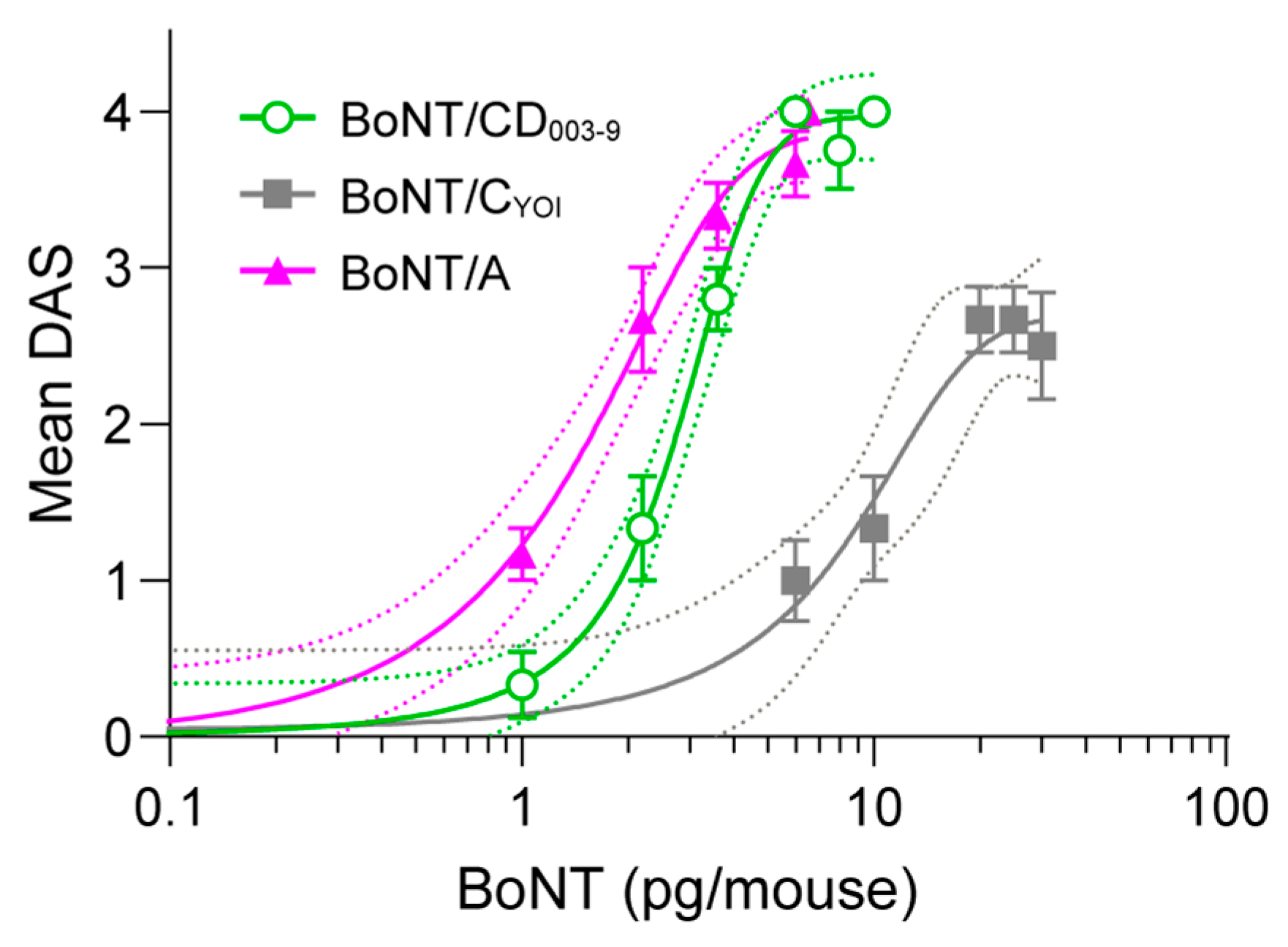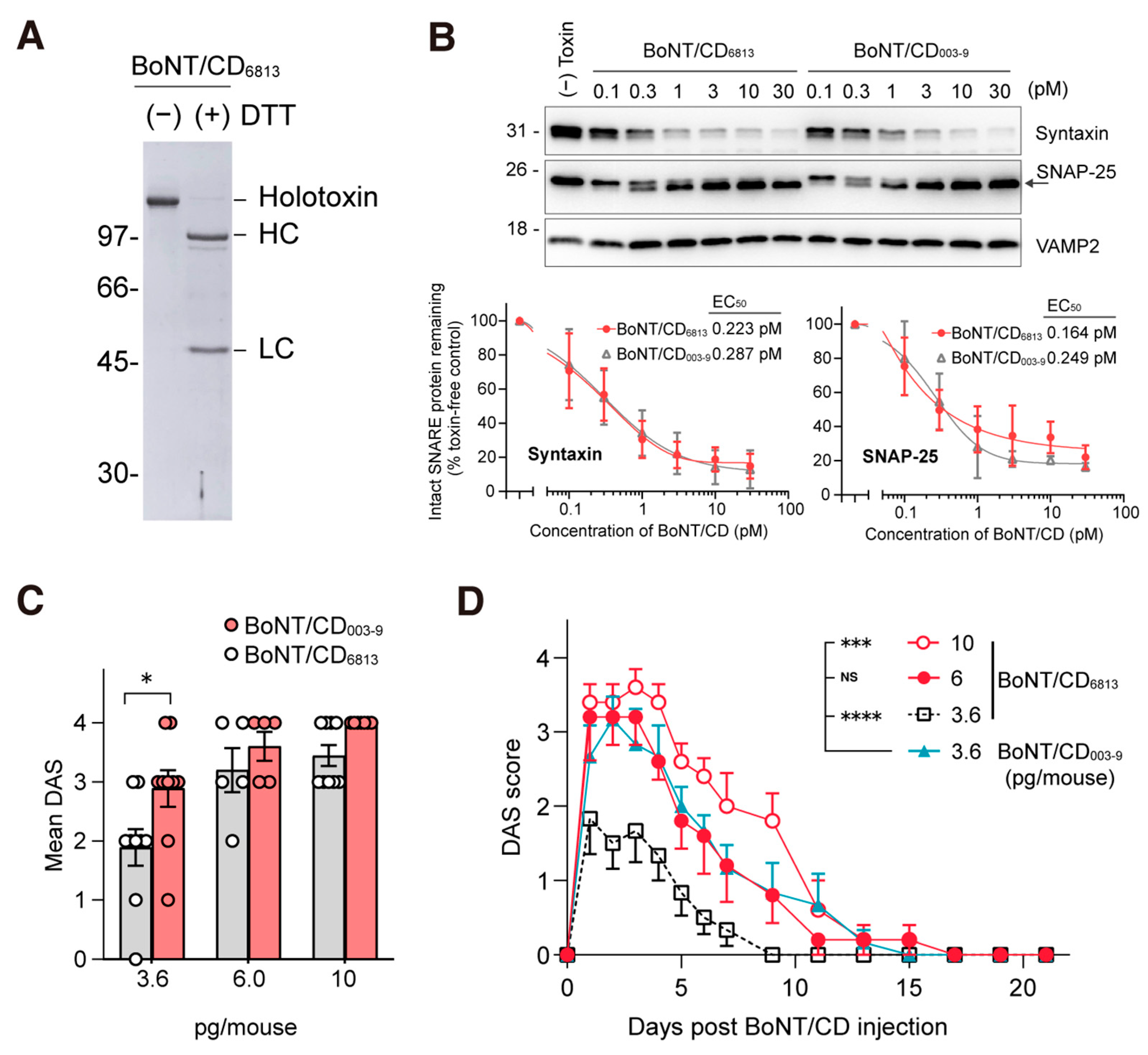Characterization of Serotype CD Mosaic Botulinum Neurotoxin in Comparison with Serotype C and A
Abstract
:1. Introduction
2. Results
2.1. Domain Architecture and Purification of BoNT/CD
2.2. BoNT/CD003-9 More Efficiently Cleaved SNARE Proteins than BoNT/C and BoNT/A in Rat-Cultured Cortical Neurons
2.3. Local Muscle Paralysis by BoNT/CD in Mice
2.4. Sequence Variations in the Receptor Binding Domains of BoNT/CD

2.5. Efficacy of BoNT/CD from Strain 6813 Compared with That from Strain 003-9
3. Discussion
4. Conclusions
5. Materials and Methods
5.1. Materials
5.2. Production and Purification of Neurotoxins
5.3. Neuron Culture
5.4. SNARE Protein Cleavage in Cultured Neurons
5.5. Sequence Analysis
5.6. DAS Assay
5.7. Statistical Analysis
5.8. Ethics Statement
Supplementary Materials
Author Contributions
Funding
Institutional Review Board Statement
Informed Consent Statement
Data Availability Statement
Acknowledgments
Conflicts of Interest
References
- Rasetti-Escargueil, C.; Lemichez, E.; Popoff, M.R. Public Health Risk Associated with Botulism as Foodborne Zoonoses. Toxins 2019, 12, 17. [Google Scholar] [CrossRef]
- Arnon, S.S.; Schechter, R.; Inglesby, T.V.; Henderson, D.A.; Bartlett, J.G.; Ascher, M.S.; Eitzen, E.; Fine, A.D.; Hauer, J.; Layton, M.; et al. Botulinum Toxin as a Biological Weapon: Medical and Public Health Management. JAMA 2001, 285, 1059–1070. [Google Scholar] [CrossRef]
- Fonfria, E.; Maignel, J.; Lezmi, S.; Martin, V.; Splevins, A.; Shubber, S.; Kalinichev, M.; Foster, K.; Picaut, P.; Krupp, J. The Expanding Therapeutic Utility of Botulinum Neurotoxins. Toxins 2018, 10, 208. [Google Scholar] [CrossRef]
- Dong, M.; Masuyer, G.; Stenmark, P. Botulinum and Tetanus Neurotoxins. Annu. Rev. Biochem. 2019, 88, 811–837. [Google Scholar] [CrossRef]
- Matak, I.; Bölcskei, K.; Bach-Rojecky, L.; Helyes, Z. Mechanisms of Botulinum Toxin Type A Action on Pain. Toxins 2019, 11, 459. [Google Scholar] [CrossRef]
- Eleopra, R.; Rinaldo, S.; Montecucco, C.; Rossetto, O.; Devigili, G. Clinical Duration of Action of Different Botulinum Toxin Types in Humans. Toxicon 2020, 179, 84–91. [Google Scholar] [CrossRef]
- Naumann, M.; Boo, L.M.; Ackerman, A.H.; Gallagher, C.J. Immunogenicity of Botulinum Toxins. J. Neural Transm. 2013, 120, 275–290. [Google Scholar] [CrossRef]
- Pirazzini, M.; Montecucco, C.; Rossetto, O. Toxicology and Pharmacology of Botulinum and Tetanus Neurotoxins: An Update. Arch. Toxicol. 2022, 96, 1521–1539. [Google Scholar] [CrossRef]
- Rossetto, O.; Pirazzini, M.; Montecucco, C. Botulinum Neurotoxins: Genetic, Structural and Mechanistic Insights. Nat. Rev. Microbiol. 2014, 12, 535–549. [Google Scholar] [CrossRef]
- Davletov, B.; Bajohrs, M.; Binz, T. Beyond BOTOX: Advantages and Limitations of Individual Botulinum Neurotoxins. Trends Neurosci. 2005, 28, 446–452. [Google Scholar] [CrossRef]
- Pantano, S.; Montecucco, C. The Blockade of the Neurotransmitter Release Apparatus by Botulinum Neurotoxins. Cell. Mol. Life Sci. 2014, 71, 793–811. [Google Scholar] [CrossRef]
- Vagin, O.; Tokhtaeva, E.; Garay, P.E.; Souda, P.; Bassilian, S.; Whitelegge, J.P.; Lewis, R.; Sachs, G.; Wheeler, L.; Aoki, R.; et al. Recruitment of Septin Cytoskeletal Proteins by Botulinum Toxin A Protease Determines Its Remarkable Stability. J. Cell Sci. 2014, 127, 3294–3308. [Google Scholar] [CrossRef]
- Tsai, Y.C.; Kotiya, A.; Kiris, E.; Yang, M.; Bavari, S.; Tessarollo, L.; Oyler, G.A.; Weissman, A.M. Deubiquitinating Enzyme VCIP135 Dictates the Duration of Botulinum Neurotoxin Type A Intoxication. Proc. Natl. Acad. Sci. USA 2017, 114, 5158–5166. [Google Scholar] [CrossRef]
- Eleopra, R.; Tugnoli, V.; Rossetto, O.; Montecucco, C.; De Grandis, D. Botulinum Neurotoxin Serotype C: A Novel Effective Botulinum Toxin Therapy in Human. Neurosci. Lett. 1997, 224, 91–94. [Google Scholar] [CrossRef]
- Eleopra, R.; Tugnoli, V.; Quatrale, R.; Rosetto, O.; Montecucco, C. Different Types of Botulinum Toxin in Humans. Mov. Disord. 2004, 19, 53–59. [Google Scholar] [CrossRef]
- Zanetti, G.; Sikorra, S.; Rummel, A.; Krez, N.; Duregotti, E.; Negro, S.; Henke, T.; Rossetto, O.; Binz, T.; Pirazzini, M. Botulinum Neurotoxin C Mutants Reveal Different Effects of Syntaxin or SNAP-25 Proteolysis on Neuromuscular Transmission. PLoS Pathog. 2017, 13, e1006567. [Google Scholar] [CrossRef]
- Dong, M.; Yeh, F.; Tepp, W.H.; Dean, C.; Johnson, E.A.; Janz, R.; Chapman, E.R. SV2 Is the Protein Receptor for Botulinum Neurotoxin A. Science 2006, 312, 592–596. [Google Scholar] [CrossRef]
- Mahrhold, S.; Rummel, A.; Bigalke, H.; Davletov, B.; Binz, T. The Synaptic Vesicle Protein 2C Mediates the Uptake of Botulinum Neurotoxin A into Phrenic Nerves. FEBS Lett. 2006, 580, 2011–2014. [Google Scholar] [CrossRef]
- Wang, J.; Meng, J.; Lawrence, G.W.; Zurawski, T.H.; Sasse, A.; Bodeker, M.O.; Gilmore, M.A.; Fernández-Salas, E.; Francis, J.; Steward, L.E.; et al. Novel Chimeras of Botulinum Neurotoxins A and E Unveil Contributions from the Binding, Translocation, and Protease Domains to Their Functional Characteristics. J. Biol. Chem. 2008, 283, 16993–17002. [Google Scholar] [CrossRef]
- Wang, J.; Zurawski, T.H.; Bodeker, M.O.; Meng, J.; Boddul, S.; Aoki, K.R.; Dolly, J.O. Longer-Acting and Highly Potent Chimaeric Inhibitors of Excessive Exocytosis Created with Domains from Botulinum Neurotoxin A and B. Biochem. J. 2012, 444, 59–67. [Google Scholar] [CrossRef]
- Pellett, S.; Tepp, W.H.; Lin, G.; Johnson, E.A. Substrate Cleavage and Duration of Action of Botulinum Neurotoxin Type FA (“H, HA”). Toxicon 2018, 147, 38–46. [Google Scholar] [CrossRef] [PubMed]
- Moriishi, K.; Koura, M.; Abe, N.; Fujii, N.; Fujinaga, Y.; Inoue, K.; Ogumad, K. Mosaic Structures of Neurotoxins Produced from Clostridium Botulinum Types C and D Organisms. Biochim. Et Biophys. Acta Gene Struct. Expr. 1996, 1307, 123–126. [Google Scholar] [CrossRef] [PubMed]
- Takeda, M.; Tsukamoto, K.; Kohda, T.; Matsui, M.; Mukamoto, M.; Kozaki, S. Characterization of the Neurotoxin Produced by Isolates Associated with Avian Botulism. Avian Dis. 2005, 49, 376–381. [Google Scholar] [CrossRef] [PubMed]
- Nakamura, K.; Kohda, T.; Shibata, Y.; Tsukamoto, K.; Arimitsu, H.; Hayashi, M.; Mukamoto, M.; Sasakawa, N.; Kozaki, S. Unique Biological Activity of Botulinum D/C Mosaic Neurotoxin in Murine Species. Infect. Immun. 2012, 80, 2886–2893. [Google Scholar] [CrossRef] [PubMed]
- Eleopra, R.; Montecucco, C.; Devigili, G.; Lettieri, C.; Rinaldo, S.; Verriello, L.; Pirazzini, M.; Caccin, P.; Rossetto, O. Botulinum Neurotoxin Serotype D Is Poorly Effective in Humans: An in Vivo Electrophysiological Study. Clin. Neurophysiol. 2013, 124, 999–1004. [Google Scholar] [CrossRef]
- Dressler, D.; Kollewe, K.; Kruger, T.H.C.; Gade, N.; Sikorra, S.; Bigalke, H. Botulinum Toxin Type D Blocks Autonomic Cholinergic Synapses in Humans: Discussion of a Potential Therapeutic Use. J. Neural Transm. 2019, 126, 1337–1340. [Google Scholar] [CrossRef] [PubMed]
- Tsukamoto, K.; Kohda, T.; Mukamoto, M.; Takeuchi, K.; Ihara, H.; Saito, M.; Kozaki, S. Binding of Clostridium Botulinum Type C and D Neurotoxins to Ganglioside and Phospholipid: Novel Insights into the Receptor for Clostridial Neurotoxins. J. Biol. Chem. 2005, 280, 35164–35171. [Google Scholar] [CrossRef]
- Peng, L.; Tepp, W.H.; Johnson, E.A.; Dong, M. Botulinum Neurotoxin D Uses Synaptic Vesicle Protein SV2 and Gangliosides as Receptors. PLoS Pathog. 2011, 7, e1002008. [Google Scholar] [CrossRef]
- Zhang, S.; Lebreton, F.; Mansfield, M.J.; Miyashita, S.-I.; Zhang, J.; Schwartzman, J.; Tao, L.; Masuyer, G.; Martínez-Carranza, M.; Stenmark, P.; et al. Identification of a Botulinum Neurotoxin-like Toxin in a Commensal Strain of Enterococcus Faecium. Cell Host Microbe 2018, 23, 169–176. [Google Scholar] [CrossRef]
- Karalewitz, A.P.A.; Fu, Z.; Baldwin, M.R.; Kim, J.J.P.; Barbieri, J.T. Botulinum Neurotoxin Serotype C Associates with Dual Ganglioside Receptors to Facilitate Cell Entry. J. Biol. Chem. 2012, 287, 40806–40816. [Google Scholar] [CrossRef] [Green Version]
- Strotmeier, J.; Gu, S.; Jutzi, S.; Mahrhold, S.; Zhou, J.; Pich, A.; Eichner, T.; Bigalke, H.; Rummel, A.; Jin, R.; et al. The Biological Activity of Botulinum Neurotoxin Type C Is Dependent upon Novel Types of Ganglioside Binding Sites. Mol. Microbiol. 2011, 81, 143–156. [Google Scholar] [CrossRef] [PubMed]
- Foran, P.G.; Mohammed, N.; Lisk, G.O.; Nagwaney, S.; Lawrence, G.W.; Johnson, E.; Smith, L.; Roger Aoki, K.; Dolly, O.J. Evaluation of the Therapeutic Usefulness of Botulinum Neurotoxin B, C1, E, and F Compared with the Long Lasting Type A: Basis for Distinct Durations of Inhibition of Exocytosis in Central Neurons. J. Biol. Chem. 2003, 278, 1363–1371. [Google Scholar] [CrossRef]
- Morbiato, L.; Carli, L.; Johnson, E.A.; Montecucco, C.; Molgó, J.; Rossetto, O. Neuromuscular Paralysis and Recovery in Mice Injected with Botulinum Neurotoxins A and C. Eur. J. Neurosci. 2007, 25, 2697–2704. [Google Scholar] [CrossRef] [PubMed]
- Hasegawa, K.; Watanabe, T.; Suzuki, T.; Yamano, A.; Oikawa, T.; Sato, Y.; Kouguchi, H.; Yoneyama, T.; Niwa, K.; Ikeda, T.; et al. A Novel Subunit Structure of Clostridium Botulinum Serotype D Toxin Complex with Three Extended Arms. J. Biol. Chem. 2007, 282, 24777–24783. [Google Scholar] [CrossRef] [PubMed]
- Lam, K.H.; Jin, R. Architecture of the Botulinum Neurotoxin Complex: A Molecular Machine for Protection and Delivery. Curr. Opin. Struct. Biol. 2015, 31, 89–95. [Google Scholar] [CrossRef] [PubMed]
- Collins, M.D.; East, A.K. Phylogeny and Taxonomy of the Food-Borne Pathogen Clostridium Botulinum and Its Neurotoxins. J. Appl. Microbiol. 1998, 84, 5–17. [Google Scholar] [CrossRef]
- Aoki, K.R. Botulinum Neurotoxin Serotypes A and B Preparations Have Different Safety Margins in Preclinical Models of Muscle Weakening Efficacy and Systemic Safety. Toxicon 2002, 40, 923–928. [Google Scholar] [CrossRef]
- Miyashita, S.-I.; Zhang, J.; Zhang, S.; Shoemaker, C.B.; Dong, M. Delivery of Single-Domain Antibodies into Neurons Using a Chimeric Toxin–Based Platform Is Therapeutic in Mouse Models of Botulism. Sci. Transl. Med. 2021, 13, eaaz4197. [Google Scholar] [CrossRef]
- Donald, S.; Elliott, M.; Gray, B.; Hornby, F.; Lewandowska, A.; Marlin, S.; Favre-Guilmard, C.; Périer, C.; Cornet, S.; Kalinichev, M.; et al. A Comparison of Biological Activity of Commercially Available Purified Native Botulinum Neurotoxin Serotypes A1 to F1 in Vitro, Ex Vivo, and in Vivo. Pharmacol. Res. Perspect. 2018, 6, e00446. [Google Scholar] [CrossRef]
- Tsukamoto, K.; Kozai, Y.; Ihara, H.; Kohda, T.; Mukamoto, M.; Tsuji, T.; Kozaki, S. Identification of the Receptor-Binding Sites in the Carboxyl-Terminal Half of the Heavy Chain of Botulinum Neurotoxin Types C and D. Microb. Pathog. 2008, 44, 484–493. [Google Scholar] [CrossRef]
- Zhang, Y.; Buchko, G.W.; Qin, L.; Robinson, H.; Varnum, S.M. Crystal Structure of the Receptor Binding Domain of the Botulinum C-D Mosaic Neurotoxin Reveals Potential Roles of Lysines 1118 and 1136 in Membrane Interactions. Biochem. Biophys. Res. Commun. 2011, 404, 407–412. [Google Scholar] [CrossRef] [PubMed]
- Anandan, C.; Jankovic, J. Botulinum Toxin in Movement Disorders: An Update. Toxins 2021, 13, 42. [Google Scholar] [CrossRef]
- Satriyasa, B.K. Botulinum Toxin (Botox) A for Reducing the Appearance of Facial Wrinkles: A Literature Review of Clinical Use and Pharmacological Aspect. Clin. Cosmet. Investig. Dermatol. 2019, 12, 223–228. [Google Scholar] [CrossRef]
- Bellows, S.; Jankovic, J. Immunogenicity Associated with Botulinum Toxin Treatment. Toxins 2019, 11, 491. [Google Scholar] [CrossRef]
- Atassi, M.Z. Molecular Basis of Immunogenicity to Botulinum Neurotoxins and Uses of the Defined Antigenic Regions. Toxicon 2015, 107, 50–58. [Google Scholar] [CrossRef]
- Benecke, R. Clinical Relevance of Botulinum Toxin Immunogenicity. BioDrugs 2012, 26, 1–9. [Google Scholar] [CrossRef]
- Shone, C.C.; Hambleton, P.; Melling, J. Inactivation of Clostridium Botulinum Type A Neurotoxin by Trypsin and Purification of Two Tryptic Fragments: Proteolytic Action near the COOH-terminus of the Heavy Subunit Destroys Toxin-binding Activity. Eur. J. Biochem. 1985, 151, 75–82. [Google Scholar] [CrossRef]
- Pellett, S.; Tepp, W.H.; Bradshaw, M.; Kalb, S.R.; Dykes, J.K.; Lin, G.; Nawrocki, E.M.; Pier, C.L.; Barr, J.R.; Maslanka, S.E.; et al. Purification and Characterization of Botulinum Neurotoxin FA from a Genetically Modified Clostridium Botulinum Strain. mSphere 2016, 1, e00100-15. [Google Scholar] [CrossRef]
- Strotmeier, J.; Lee, K.; Völker, A.K.; Mahrhold, S.; Zong, Y.; Zeiser, J.; Zhou, J.; Pich, A.; Bigalke, H.; Binz, T.; et al. Botulinum Neurotoxin Serotype D Attacks Neurons via Two Carbohydrate-Binding Sites in a Ganglioside-Dependent Manner. Biochem. J. 2010, 431, 207–216. [Google Scholar] [CrossRef]
- Hasegawa, K.; Watanabe, T.; Sato, H.; Sagane, Y.; Mutoh, S.; Suzuki, T.; Yamano, A.; Kouguchi, H.; Takeshi, K.; Kamaguchi, A.; et al. Characterization of Toxin Complex Produced by a Unique Strain of Clostridium Botulinum Serotype D 4947. Protein J. 2004, 23, 371–378. [Google Scholar] [CrossRef]
- Watanabe, T.; Sagane, Y.; Kouguchi, H.; Sunagawa, H.; Inoue, K.; Fujinaga, Y.; Oguma, K.; Ohyama, T. Molecular Composition of Progenitor Toxin Produced by Clostridium Botulinum Type C Strain 6813. J. Protein Chem. 1999, 18, 753–760. [Google Scholar] [CrossRef] [PubMed]





Disclaimer/Publisher’s Note: The statements, opinions and data contained in all publications are solely those of the individual author(s) and contributor(s) and not of MDPI and/or the editor(s). MDPI and/or the editor(s) disclaim responsibility for any injury to people or property resulting from any ideas, methods, instructions or products referred to in the content. |
© 2023 by the authors. Licensee MDPI, Basel, Switzerland. This article is an open access article distributed under the terms and conditions of the Creative Commons Attribution (CC BY) license (https://creativecommons.org/licenses/by/4.0/).
Share and Cite
Miyashita, S.-I.; Karatsu, S.; Fujiishi, M.; Huang, I.H.; Nagashima, Y.; Morobishi, T.; Hosoya, K.; Hata, T.; Dong, M.; Sagane, Y. Characterization of Serotype CD Mosaic Botulinum Neurotoxin in Comparison with Serotype C and A. Toxins 2023, 15, 123. https://doi.org/10.3390/toxins15020123
Miyashita S-I, Karatsu S, Fujiishi M, Huang IH, Nagashima Y, Morobishi T, Hosoya K, Hata T, Dong M, Sagane Y. Characterization of Serotype CD Mosaic Botulinum Neurotoxin in Comparison with Serotype C and A. Toxins. 2023; 15(2):123. https://doi.org/10.3390/toxins15020123
Chicago/Turabian StyleMiyashita, Shin-Ichiro, Shura Karatsu, Mako Fujiishi, I Hsun Huang, Yuki Nagashima, Tamaki Morobishi, Keita Hosoya, Tsuyoshi Hata, Min Dong, and Yoshimasa Sagane. 2023. "Characterization of Serotype CD Mosaic Botulinum Neurotoxin in Comparison with Serotype C and A" Toxins 15, no. 2: 123. https://doi.org/10.3390/toxins15020123




